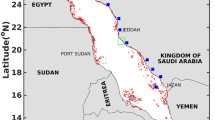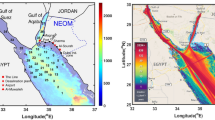Abstract
More than 20% of global liquefied natural gas (LNG) exports and almost all of Qatar’s drinking water production originate from three industrial sites on Qatar’s eastern coast. They are all vulnerable to oil spills, and this vulnerability remains largely unquantified. Here we model oil-spill dispersal in the shallow maritime waters surrounding Qatar to identify which offshore areas and times of the year pose the greatest threat to the nation’s LNG export and seawater desalination facilities. By combining oil transport simulations with marine traffic data, we identify two high-risk areas, sizing up to ~15% of Qatar’s maritime exclusive economic zone. Ras Laffan’s LNG terminal has the highest vulnerability to oil spills all year, and its desalination plant, producing 30% of the national water supply, has a seasonal vulnerability peaking to an alarming level twice a year during spring and fall. Both LNG export and desalination facilities could be impacted by oil spills occurring outside of Qatar’s maritime borders in less than three days. We suggest that offshore high-risk areas be closely monitored with airborne and satellite synthetic-aperture radar providing early warning for oil spills that could severely disrupt Qatar’s LNG exports, further aggravating the global gas crisis.
This is a preview of subscription content, access via your institution
Access options
Access Nature and 54 other Nature Portfolio journals
Get Nature+, our best-value online-access subscription
$29.99 / 30 days
cancel any time
Subscribe to this journal
Receive 12 digital issues and online access to articles
$119.00 per year
only $9.92 per issue
Buy this article
- Purchase on Springer Link
- Instant access to full article PDF
Prices may be subject to local taxes which are calculated during checkout




Similar content being viewed by others
Data availability
The oil-dispersal simulation outputs for every month and every coastal infrastructure are available at https://zenodo.org/record/7340698 (https://doi.org/10.5281/zenodo.7340697). The atmospheric and oceanic circulation data used to force the oil-dispersal model are freely available at https://www.ecmwf.int/en/forecasts/datasets/reanalysis-datasets/era5 and https://data.marine.copernicus.eu/products. The marine traffic data used to compute the shipping exposure indicator can be purchased at https://www.marinetraffic.com/en/p/ais-historical-data.
Code availability
The oil-spill dispersal simulations were performed with the open-source model OpenOil (version 1.60) available at https://opendrift.github.io. The Python programmes used to produce the key results of this study are available at https://forge.uclouvain.be/dobbelaeret/scripts_anselain2022_natsustain.
References
GIIGNL 2021 Annual Report (GIIGNL, 2021); https://giignl.org/publications/giignl-2021-annual-report
Hofste, R. W., Reig, P. & Schleifer, L. 17 Countries, Home to One-Quarter of the World’s Population, Face Extremely High Water Stress (World Resources Institute, 2019)
Abotalib, A. Z., Heggy, E., Scabbia, G. & Mazzoni, A. Groundwater dynamics in fossil fractured carbonate aquifers in Eastern Arabian Peninsula: a preliminary investigation. J. Hydrol. 571, 460–470 (2019).
Mohieldeen, Y. E., Elobaid, E. A. & Abdalla, R. GIS-based framework for artificial aquifer recharge to secure sustainable strategic water reserves in Qatar arid environment peninsula. Sci. Rep. 11, 18184 (2021).
Darwish, M. A. & Mohtar, R. Qatar water challenges. Desalination Water Treat. 51, 75–86 (2013).
Hussein, H. & Lambert, L. A rentier state under blockade: Qatar’s water–energy–food predicament from energy abundance and food insecurity to a silent water crisis. Water 12, 1051 (2020).
Water Sector (Kahramaa, accessed 30 August 2022); https://www.km.qa/Aboutus/Pages/Watersector.aspx
Annual Statistics Report 2020 (Kahramaa, 2021); https://www.km.qa/MediaCenter/Publications/Annual%20Statistics%20Report%202020%20English.pdf (2021)
Dale, S. bp Statistical Review of World Energy 2021 (bp, 2022); https://www.bp.com/content/dam/bp/business-sites/en/global/corporate/pdfs/energy-economics/statistical-review/bp-stats-review-2022-full-report.pdf
El Gamal, R. Qatar Petroleum signs deal for mega-LNG expansion. Reuters (8 February 2021).
Global Gas Outlook to 2050 (McKinsey & Company, 2021); https://www.mckinsey.com/~/media/mckinsey/industries/oil%20and%20gas/our%20insights/global%20gas%20outlook%20to%202050/global-gas-outlook-2050-executive-summary.pdf
Surkes, S. 2017 oil spill closed three desalination plants for three days, official reveals. The Times of Israel (19 March 2021).
Aizhu, C. & Blanchard, B. China seals oil port after spill. Reuters (19 July 2010).
Huynh, B. Q. et al. Public health impacts of an imminent Red Sea oil spill. Nat. Sustain. https://doi.org/10.1038/s41893-021-00774-8 (2021).
Annual Statistical Bulletin (OPEC, 2021); https://asb.opec.org
Evtushenko, N., Ivanov, A. & Evtushenko, V. in Advances in Remote Sensing and Geo Informatics Applications (eds El-Askary, H. M. et al.) 343–347 (Springer, 2019).
Sheppard, C. et al. The Gulf: a young sea in decline. Mar. Pollut. Bull. 60, 13–38 (2010).
Worldwide Rig Counts—Current & Historical Data (Baker Hughes, 2021); https://rigcount.bakerhughes.com/intl-rig-count
Garcia-Pineda, O. et al. Classification of oil spill by thicknesses using multiple remote sensors. Remote Sens. Environ. 236, 111421 (2020).
Al Azhar, M., Temimi, M., Zhao, J. & Ghedira, H. Modeling of circulation in the Arabian Gulf and the Sea of Oman: skill assessment and seasonal thermohaline structure. J. Geophys. Res. Oceans 121, 1700–1720 (2016).
Thoppil, P. G. & Hogan, P. J. A modeling study of circulation and eddies in the Persian Gulf. J. Phys. Oceanogr. 40, 2122–2134 (2010).
Thoppil, P. G. & Hogan, P. J. Persian Gulf response to a wintertime shamal wind event. Deep Sea Res. 1 57, 946–955 (2010).
Yu, Y., Notaro, M., Kalashnikova, O. V. & Garay, M. J. Climatology of summer shamal wind in the Middle East: summer shamal climatology. J. Geophys. Res. Atmos. 121, 289–305 (2016).
Tahir, F., Baloch, A. A. B. & Ali, H. in Sustainability Perspectives: Science, Policy and Practice: A Global View of Theories, Policies and Practice in Sustainable Development (eds Khaiter, P. A. & Erechtchoukova, M. G.) 303–329 (Springer, 2020); https://doi.org/10.1007/978-3-030-19550-2_15
Benzene (ATSDR, 2015); https://www.atsdr.cdc.gov/sites/toxzine/docs/benzene_toxzine.pdf
Al-Amirah, A. S. The Nowruz oil spill in the Arabian Gulf: case study of Saudi Arabia. Geogr. Bull. 37, 16–32 (1985).
Marhoon, Y. Qatar Response Plan Version 5 (OSRL, 2021); https://www.oilspillresponse.com/globalassets/external-links/covid-19-updates/emea---qatar-response-090420-1030.pdf
Global LNG Market Outlook 2022–26 (Bloomberg, 2022); https://bbgmktg.turtl.co/story/global-lng-market-outlook/
Commodity Markets (World Bank, accessed 23 August 2022); https://www.worldbank.org/en/research/commodity-markets
Stapczynski, S. Global energy crunch is making gas too pricey for Asia. Bloomberg (17 June 2022).
Yep, E. Factbox: Asia-Pacific economies face escalating energy crisis. S&P Global Commodity Insights (27 June 2022).
Gill, J. Analysis: heat or eat? Winter protests loom as energy poverty sweeps Europe. Reuters (25 August 2022).
Twidale, S. & Buli, N. EU gas price rockets higher after Russia halts Nord Stream flows. Reuters (5 September 2022).
Water Security Mega Reservoirs Project (Kahramaa, accessed 11 October 2021); http://www.watermegareservoirs.qa
Natural-gas prices are spiking around the world. The Economist (21 September 2021).
Dagestad, K.-F., Röhrs, J., Breivik, Ø. & Ådlandsvik, B. OpenDrift v1.0: a generic framework for trajectory modeling. Geosci. Model Dev. 11, 1405–1420 (2018) https://doi.org/10.5194/gmd-11-1405-2018
Barker, C. H. et al. Progress in operational modeling in support of oil spill response. J. Mar. Sci. Eng. 8, 668 (2020).
Röhrs, J. et al. The effect of vertical mixing on the horizontal drift of oil spills. Ocean Sci. 14, 1581–1601 (2018).
Keramea, P., Kokkos, N., Gikas, G. & Sylaios, G. Operational modeling of North Aegean oil spills forced by real-time met–ocean forecasts. J. Mar. Sci. Eng. 10, 411 (2022).
Androulidakis, Y., Kourafalou, V., Robert Hole, L., Le Hénaff, M. & Kang, H. Pathways of oil spills from potential Cuban offshore exploration: influence of ocean circulation. J. Mar. Sci. Eng. 8, 535 (2020).
Breivik, Ø., Bidlot, J.-R. & Janssen, P. A. E. M. A Stokes drift approximation based on the Phillips spectrum. Ocean Model. 100, 49–56 (2016).
Li, Z., Spaulding, M. L. & French-McCay, D. An algorithm for modeling entrainment and naturally and chemically dispersed oil droplet size distribution under surface breaking wave conditions. Mar. Pollut. Bull. 119, 145–152 (2017).
Tkalich, P. & Chan, E. S. Vertical mixing of oil droplets by breaking waves. Mar. Pollut. Bull. 44, 1219–1229 (2002).
Li, Z., Spaulding, M., French McCay, D., Crowley, D. & Payne, J. R. Development of a unified oil droplet size distribution model with application to surface breaking waves and subsea blowout releases considering dispersant effects. Mar. Pollut. Bull. 114, 247–257 (2017).
Sundby, S. A one-dimensional model for the vertical distribution of pelagic fish eggs in the mixed layer. Deep Sea Res. A 30, 645–661 (1983).
Lehr, W., Jones, R., Evans, M., Simecek-Beatty, D. & Overstreet, R. Revisions of the ADIOS oil spill model. Environ. Model. Softw. 17, 189–197 (2002).
Zodiatis, G. et al. The Mediterranean Decision Support System for Marine Safety dedicated to oil slicks predictions. Deep Sea Res. 2 133, 4–20 (2016).
Amir-Heidari, P. & Raie, M. Probabilistic risk assessment of oil spill from offshore oil wells in Persian Gulf. Mar. Pollut. Bull. 136, 291–299 (2018).
Batchelder, H. P. Forward-in-time-/backward-in-time-trajectory (FITT/BITT) modeling of particles and organisms in the coastal ocean. J. Atmos. Ocean. Technol. 23, 727–741 (2006).
Ciappa, A. C. Reverse trajectory study of oil spill risk in Cyclades Islands of the Aegean Sea. Reg. Stud. Mar. Sci. 41, 101580 (2021).
Suneel, V., Ciappa, A. & Vethamony, P. Backtrack modeling to locate the origin of tar balls depositing along the west coast of India. Sci. Total Environ. 569–570, 31–39 (2016).
Zelenke, B., O’Connor, C. & Barker, C. General NOAA Operational Modeling Environment (GNOME) Technical Documentation (NOAA OR&R, October 2012); https://response.restoration.noaa.gov/gnome_manual
De Dominicis, M., Pinardi, N., Zodiatis, G. & Archetti, R. MEDSLIK-II, a Lagrangian marine surface oil spill model for short-term forecasting—part 2: numerical simulations and validations. Geosci. Model Dev. 6, 1871–1888 (2013).
Fingas, M. in Oil Spill Science and Technology (ed. Fingas, M.) 243–273 (Elsevier, 2011); https://doi.org/10.1016/B978-1-85617-943-0.10010-3
Madec, G. NEMO ocean engine. Zenodo (2017) https://doi.org/10.5281/zenodo.3248739
Eager, R. E. et al. A climatological study of the sea and land breezes in the Arabian Gulf region. J. Geophys. Res. 113, D15106 (2008).
MarineTraffic: Global Ship Tracking Intelligence (accessed 15 May 2021) https://www.marinetraffic.com/
Etkin, D. S. et al. in Oil Spill Science and Technology 2nd edn (ed. Fingas, M.) 71–183 (Gulf Professional Publishing, 2017); https://doi.org/10.1016/B978-0-12-809413-6.00002-3
Oil Tanker Spill Statistics 2021 (ITOPF, 2022); https://www.itopf.org/knowledge-resources/data-statistics/statistics/
Quattrocchi, G. et al. An operational numerical system for oil stranding risk assessment in a high-density vessel traffic area. Front. Mar. Sci. 8, 585396 (2021).
Acknowledgements
The authors thank J. Lawler and M. Vermeersch from Qatar Environment and Energy Research Institute for the helpful discussion on the country’s oil-spill mitigation plan and B. Shomar from Qatar University for the discussion on water reserves in Qatar. Computational resources were provided by the Consortium des Équipements de Calcul Intensif (CÉCI), funded by the F.R.S.-FNRS under grant no. 2.5020.11. E. Heggy acknowledges support from the Zumberge Research and Innovation Fund of the University of Southern California (USC) allocated to the Arid Climates and Water Research Center—AWARE. Part of E. Heggy’s research was carried out at USC under contract from the Jet Propulsion Laboratory, California Institute of Technology, under a contract with the National Aeronautics and Space Administration (NASA) (OASIS-SAA-00630). The funders had no role in the study design, data collection and analysis, decision to publish or preparation of the manuscript.
Author information
Authors and Affiliations
Contributions
E. Hanert and E. Heggy designed the experiment. T.A. and T.D. conducted simulations. All the authors examined the results and wrote the manuscript.
Corresponding authors
Ethics declarations
Competing interests
The authors declare no competing interests.
Peer review
Peer review information
Nature Sustainability thanks Johannes Röhrs, Simonetta Cheli, and the other, anonymous, reviewer(s) for their contribution to the peer review of this work.
Additional information
Publisher’s note Springer Nature remains neutral with regard to jurisdictional claims in published maps and institutional affiliations.
Extended data
Supplementary information
Supplementary Video 1
Daily oceanic and atmospheric circulation patterns in the central part of the Gulf throughout the year 2020. In the summer, the oceanic circulation is dominated by a large cyclonic (that is, anticlockwise) gyre, and the atmospheric circulation is dominated by southeastward summer shamal winds. Similar, although weaker, circulation patterns are observed during winter months. In spring and autumn, the oceanic circulation is more variable with more mesoscale eddy activity. The atmospheric circulation is also weaker and less directional.
Rights and permissions
Springer Nature or its licensor (e.g. a society or other partner) holds exclusive rights to this article under a publishing agreement with the author(s) or other rightsholder(s); author self-archiving of the accepted manuscript version of this article is solely governed by the terms of such publishing agreement and applicable law.
About this article
Cite this article
Anselain, T., Heggy, E., Dobbelaere, T. et al. Qatar Peninsula’s vulnerability to oil spills and its implications for the global gas supply. Nat Sustain 6, 273–283 (2023). https://doi.org/10.1038/s41893-022-01037-w
Received:
Accepted:
Published:
Issue Date:
DOI: https://doi.org/10.1038/s41893-022-01037-w



